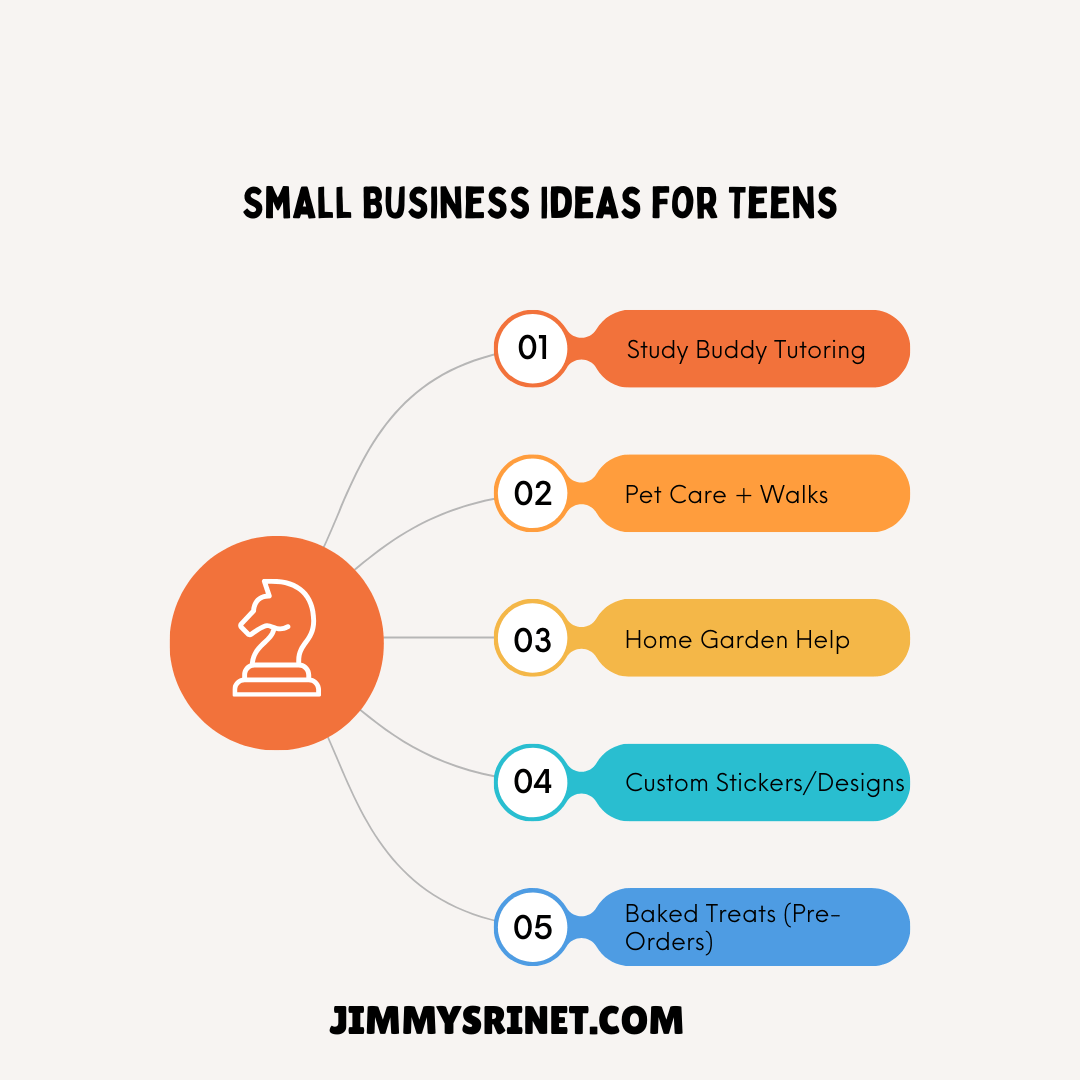Starting a small business as a teen is not just about earning pocket money—it’s a fast track to learning real-world skills: problem-solving, budgeting, communication, and time management.
Small Business Ideas for Teens: A Step-by-Step Guide 2025
The best part? You can start small, keep it flexible around school, and grow as you learn. Here’s a clear, step-by-step roadmap plus teen-friendly ideas you can launch with little to no money.
Step 1: Pick a Problem You Can Solve
Great businesses solve simple, local problems. Look for gaps around you:
- Parents need reliable after-school help.
- Neighbors want healthier snack options.
- Classmates struggle with notes or organizing.
- Local stores need better Instagram photos.
Write three problems you notice this week and match each to one skill you already have (e.g., art → custom stickers; fitness → beginner workouts; organization → study coaching).
Step 2: Validate Fast (Talk to 5–10 People)
Before you design a logo, make sure anyone cares. Ask:
- “Would this be useful to you or someone you know?”
- “How much would you pay?”
- “What day/time would you want it?”
Track answers in a simple spreadsheet. If people hesitate to pay, adjust your offer (smaller package, faster delivery, clearer results).
Step 3: Choose a Simple, Low-Risk Model
Pick a model that fits your time and resources:
- Services: tutoring, pet care, yard work, errand runs, tech setup.
- Products: handmade crafts, digital downloads, baked goods.
- Content: short-form videos, niche blogs, study resources.
Services start faster (no inventory). Products scale later (repeatable).
Parental/guardian check: confirm any age-related rules in your area, get permission if you’ll visit homes, handle food, or sell at markets.
Step 4: Set Up the Basics in One Afternoon
- Name: Keep it short and clear (e.g., “Study Buddy Notes”).
- Offer: One-sentence promise: “I help 9th–10th graders raise math scores with 1:1 practice sessions.”
- Price: Start with a flat rate. Example: ₹250–₹400 per hour for tutoring, ₹150 per dog walk, ₹300 lawn trim.
- Tools:
- Free design: Canva
- Scheduling: Google Calendar
- Payments: UPI/QR code, cash
- Invoices/records: Google Sheets
- Safety & boundaries: Only meet in public places or with parents at home; set work hours (e.g., 4–7 pm, Mon–Fri; 10–2 Sat).
Step 5: Create a 1-Page Pitch
Answer four questions:
- Who do you help? (e.g., busy pet owners in my neighborhood)
- What outcome do they get? (daily walks, photos, on-time feeding)
- Why you? (reliable, trained, references)
- How much? (clear pricing + package)
Example pitch:
“I help busy families in Sector 12 by walking dogs on school days. Each 25-minute walk includes water, route photo, and a quick update—₹150 per walk or ₹650 for 5 walks/week.”
Step 6: Find Your First 5 Customers
- Ask people you already know (teachers, neighbors, relatives).
- Post a parent-approved flyer on community boards and WhatsApp groups.
- Offer a “first-week intro”: 20% off or a free add-on (not free labor forever).
- Collect one review per customer (screenshot or message). Social proof sells.
Mini script for DMs:
“Hi! I’m [Name], a student at [School]. I’m offering [service] for [who] with [benefit]. I have [2] openings this week. Would you like to try the intro offer: [deal]?”
Step 7: Deliver Like a Pro (Even If You’re New)
- Be on time. Message if you’ll be early/late.
- Confirm scope. “Today: 60-minute algebra revision + 3 exam-style questions.”
- Track results. Before/after photos, grades, timing, or testimonials.
- Follow up. “We covered fractions today. Next session: word problems. Want to book Wed 5 pm?”
Small upgrades that feel premium:
- Branded checklist or care card.
- Progress tracker for tutoring or fitness.
- Quality photos for pets, products, or events.
Step 8: Price for Profit (and Fairness)
Start low, raise steadily. A simple method:
- Decide your target hourly rate (e.g., ₹300/hour).
- Estimate time per job (including travel/prep).
- Add costs (materials/transport) + small buffer.
- Set package deals (e.g., “5 lessons for the price of 4.5”).
If you’re always fully booked, raise prices 10–20% for new clients and add value (longer sessions, templates, or faster delivery).
Step 9: Market Smarter, Not Louder
- Before/After showcased: study score rises, garden makeovers, desk declutters.
- “Story” posts: what you did today + quick tip.
- Referrals: “Get ₹100 off for you and a friend when they book.”
- Local SEO lite: add your area name in bios (“Dog Walker – Sector 12, GK-2”).
- Partner up:
- Bakers ↔ event planners.
- Photographers ↔ local cafés.
- Tutors ↔ school clubs.
Step 10: Keep School First (Systems Save You)
- Time blocks: homework, business, rest.
- Weekly review (15 min): money in/out, happiest client, one improvement.
- Templates: repeat messages, invoices, and checklists to save time.
- Safety: share locations with family, avoid late visits, meet in public spots, get food-safety guidance if cooking.
Teen-Friendly Business Ideas (Pick One to Start)
- Study Buddy Tutoring: One grade level below yours, specific subjects, 60-minute sessions, homework plan included.
- Pet Care + Walks: Midday dog walks for working families; add photo updates.
- Home Garden Help: Basic weeding, watering, and seasonal planting; package monthly care.
- Custom Stickers/Designs: Create digital art in Canva/Procreate; sell on Instagram or at school fairs (with permission).
- Baked Treats (Pre-Orders): Cookies or cupcakes for birthdays; take 48-hour pre-orders; label allergens.
- Phone & Laptop Cleanup: Declutter storage, install updates, set up backups; flat fee + checklist.
- Sports/Skills Coaching: Beginner basketball drills or guitar basics for kids 8–12; small groups on weekends.
- Social Media Helper for Local Shops: Shoot product photos, write captions, schedule 8 posts/month.
- Notes & Templates Store: Sell neat, printable summaries, planners, or flashcards.
- Event Help Crew: Birthday setup, balloon inflating, return-gift packing, clean-up crew.
A One-Week Launch Plan
- Day 1: Pick idea + write your one-sentence offer.
- Day 2: Validate with 5–10 people; adjust price/offer.
- Day 3: Make a simple flyer and 3 posts; prepare a booking form (Google Form).
- Day 4: DM 15 contacts; ask for 2 trial clients.
- Day 5: Deliver your first job; collect a review.
- Day 6: Post results; offer a 5-session or 1-month package.
- Day 7: Review, tweak prices/scope, and plan your next week’s slots.
Simple Tools to Keep You Organized
- Google Sheets: income, expenses, hours.
- Google Calendar: recurring clients and exam weeks.
- Canva: flyers, price lists, templates.
- Drive/Photos: store client pics and testimonials (with permission).
Final Tip
Start tiny, learn fast, and keep promises. Your first five happy customers are more valuable than the fanciest logo. Pick one idea, follow the steps above this week, and you’ll have a real teen-run business—small, smart, and truly yours.







